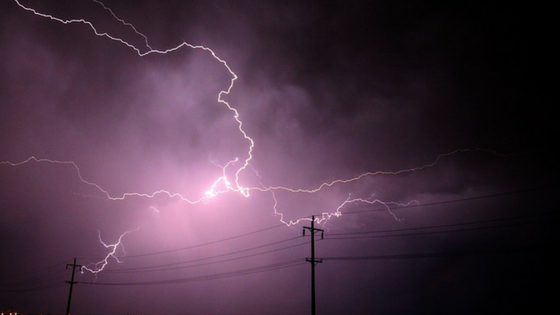Indirect Lightning Strikes

Close your eyes and picture a lightning strike. You're probably imagining dark storm clouds with a flash of light meeting a building, tree, or point. However, did you know lightning also hits the ground?
Indirect lightning strikes, or strikes that discharge their electricity into the ground, aren't as fascinating to people but they are still very powerful. Let's learn a little bit more about them so you can protect yourself during thunderstorms:
4 Things You Need to Know

1. The Difference Between Direct and Indirect Strikes
There is one main difference between direct lightning strikes and indirect lightning strikes and it's related to the way they travel. A direct hit occurs when all of the lightning's energy is directed through the body or over the body on the skin.
An indirect lightning strike can happen a couple of different ways. The first way is through a ground current. These occur when lightning strikes an object or the ground and the electricity travels through the ground until it encounters another object.
The second way is through a side flash. This happens when lightning strikes an object that seeks a path that lets it jump through the air to a second object.
2. Indirect Lightning Strikes Can Kill
According to NOAA, an average bolt of lightning carries 20,000 to 20,000 amperes of charge. Direct lightning strikes are more dangerous, but both can be incredibly damaging. Both types of strikes have enough power to kill.
In 2016, an indirect lightning strike that hit the ground in Norway killed over 300 reindeer. The electricity traveled through the ground and killed the animals during a thunderstorm. The total death toll was 323. This is just one of the many examples of the deadly powers of indirect lightning strikes.
3. Indirect Lightning Strikes are Common
In fact, direct lightning strikes only make-up about 4% of all reported strikes. Indirect lightning strikes, which product ground currents, account for about 50% of lightning injuries. Since these strikes happen a lot, it's a good idea to be prepared for them and know when lightning is in your area.
A Scary Indirect Lightning Strike Incident
On Monday, July 10, 2017, a swim instructor was on her way to work when an indirect strike sent electricity through her body. She was walking in the parking lot of the Lauderdale Lakes Swimming Pool Complex when the incident occurred. The 27-year-old woman was carrying an umbrella as she walked through the thunderstorm to the entrance of the building.
The video below shows the incident and the instructor's reaction.
New video shows moment swim instructor was jolted by lightning @CBSMiami pic.twitter.com/Iop8YJRHas
— Miguel Fernandez (@miguelcbs4) July 10, 2017
Luckily, the jolt of lightning did not seriously injure the instructor. She was able to get up and enter the building. Later she was treated at the hospital with minor injuries.






